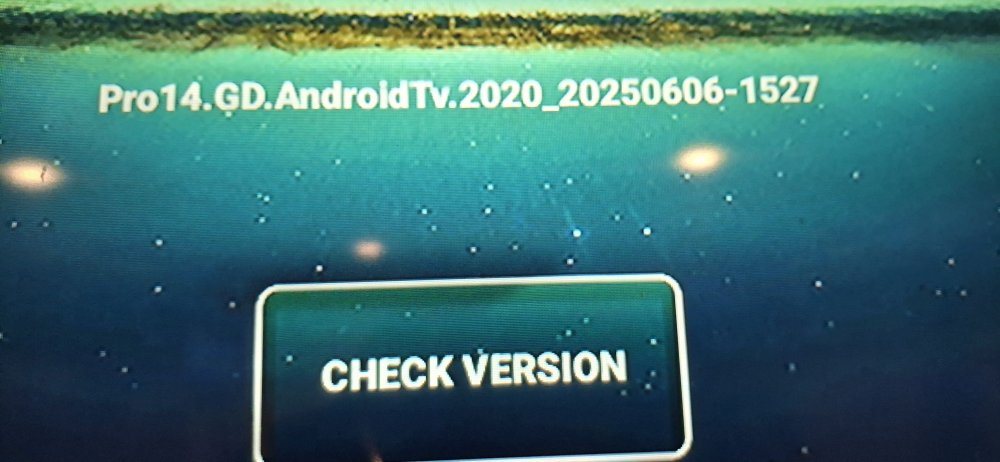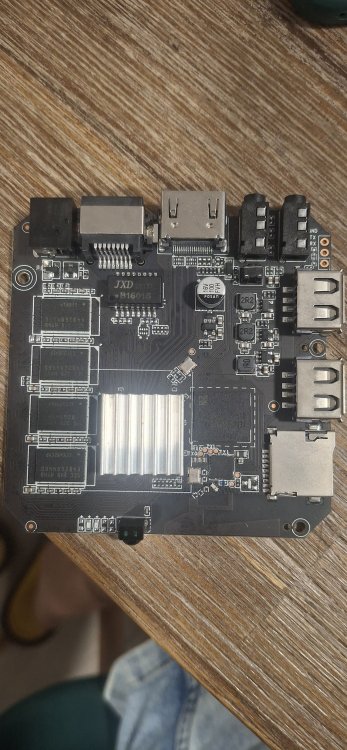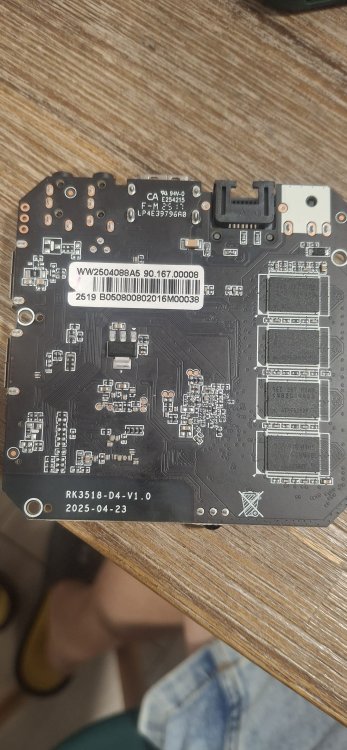Search the Community
Showing results for 'youtube'.
-
Hy all, For some time now I have a Rock 5b + with 16Gig memory. The problem I have is playback video' s in youtube. Video's are not even watcheble in the lowest resolution. Other 4k video' s play fine. I tried several bechmark video' s from online sources. I looked around to see if others experiance the same problem but cannot find anny clu in this matter. I use Armbian ver. 25.5.1 Do others have the same issue? Is there a soltion for this problem? Also I find this board not the fastest. It's a bit faster than mi RPI5 with 4Gig mem. The PI5 plays HD on youtube. I also have a OrangePi 5 ultra with 16 gig memory on stock Orangepi ubuntu witch is a dream to work with. This board is fast, has a small formfactor and became my daily PC for everything. This board also play's youtube video' s in HD. A direct comparacing with the Rock 5b+ is not possible because no Armbian version will boot on this OrangePi board sadly. I tested on wired and WiFi network with no vissible difference. Anny advise is welcome! Ernst-Jan
-
Your best bet is to compile your own image. It's super easy: "git clone https://github.com/armbian/build.git;cd build;./compile.sh" https://docs.armbian.com/Developer-Guide_Building-with-Docker/ https://docs.armbian.com/Developer-Guide_Build-Preparation/ https://www.youtube.com/watch?v=kQcEFsXEJEE
-

fail install of xfce desktop on odroidxu4
dev001 replied to dev001's topic in Software, Applications, Userspace
Made some progress. after installing Armbian_25.8.1_Odroidxu4_noble_current_6.6.102 to eMMC ran armbian-upgrade Installed xubuntu-desktop or xubuntu-desktop-minimal package reboot now i'm getting the greeter screen. after login, I entered xfce desktop. functions ok could only install firefox via snap. installed firefox via snap ran firefox to view a video on youtube. audio is not working. install pulseaudio reboot system audio still not working when viewing a youtube video any suggestions? -
It's super easy to compile your own image: "git clone https://github.com/armbian/build.git;cd build;./compile.sh" https://docs.armbian.com/Developer-Guide_Building-with-Docker/ https://docs.armbian.com/Developer-Guide_Build-Preparation/ https://www.youtube.com/watch?v=kQcEFsXEJEE FWIW, I just tried to download the two images from https://www.armbian.com/espressobin/ and did not have any issue. What problem exactly are you facing? Here's where I am being redirected to: https://github.com/armbian/os/releases/download/25.11.0-trunk.461/Armbian_25.11.0-trunk.461_Espressobin_plucky_current_6.12.57_minimal.img.xz https://github.com/armbian/os/releases/download/25.11.0-trunk.461/Armbian_25.11.0-trunk.461_Espressobin_trixie_current_6.12.57_minimal.img.xz
-
I have a RK3228A TV Box which is able to properly boot armbian when flashed to its eMMC (no rknand) . However I don't use Armbian much often, probably a maximum of two to three times a month. I want to keep stock Android on eMMC, for video playback on the YouTube app is much faster compared to in firefox and Android has proper remote support which Armbian lacks. I tried flashing the armbian community image on the sdcard but the device didn't boot from sdcard unless the eMMC was wiped. I found that multitool is able to always boot from sdcard irrespective of whatever is in the emmc. After doing some research on the multitool build process, I think I need a properly configured idbloader, uboot and tee binary and then place them at proper offsets in the image, however the Armbian image already contains different data at those offsets. So, how can I build an Armbian image that can be booted from sdcard without wiping the eMMC ?
-
@robertoj Yes, yesterday I installed ffmpeg package from jok's repository and tested mp4,webm videos through mpv/smplayer/vlc or even chromium at 1080p@30 smoothly. (@60 stuttering) It's great for software decoding. Now all I need is to watch youtube smoothly on chromium at 1080p. From what I've seen in the comments on the forums, it seems like chromium needs to be new compiled with v4l2 patch and the kernel needs to support it. This is where it gets really difficult for me.
-
Just compiled and flashed a Cinnamon desktop image. Boots fine Video over HDMI working. Audio over HDMI working. The video experience is not that much satisfying. There seems to be no graphic acceleration, yet. WebGL aquarium runs at 5 FPS with 500 fishes, 15 FPS with 100 fishes. Youtube videos are relatively laggy and you'll experience high CPU load. All the GPIO hardware stuff has not been tested, yet. No clue how to do it... Now I'd like to have some more people on board to support me by adding graphic acceleration and how to merge the M1S support now into the Armbian repo. Greetings. EDIT 1: transferring the OS from SD card do eMMC works by using armbian-install tool EDIT 2: graphic acceleration IS kind of working, glmar2-es2 gives me a score of ~177. But the web browser seems not to be accelerated. also the desktop environment seems to have problems Cinnamon is not able to load applets, which means that the "Start" menue icon is missing...
-
If anyone in interested in a lightweight wayland desktop, inspired by openbox, you should try labwc. In orange pi zero 3, we need to stay in bookworm to get video acceleration, so this guide helps build labwc in bookworm As a greeter, I chose pi-greeter, because it is the lightest login manager I could setup, without any X11 https://github.com/robertojguerra/opiz3-labwc-setup I am open to read any improvements, or show me how I could make deb packages. In the near future, I will make a step-by-step video tutorial in Youtube.
-
I followed this forum and finally bought a transpeed-8k618-t to use via a micro SD card. It's been a lot of fun and enjoyable. Even though it only displays well on YouTube at 720p/30fps, I understand the box's capabilities. I'm thinking of installing eMMC, but I'm not sure. Can anyone recommend a proper eMMC installation method? I'd appreciate it. @Nick A Are you planning on making a Debian 13 trixie version?
-
@Igor is probably in the best position to answer when a new image for your board might be available. This is actually fairly easy to do by building your own image: "git clone https://github.com/armbian/build.git;cd build;./compile.sh" https://docs.armbian.com/Developer-Guide_Building-with-Docker/ https://evilolaf.github.io/docupreview/Developer-Guide_Build-Preparation/ https://www.youtube.com/watch?v=kQcEFsXEJEE
-
thank you so much for the link, after trying some of the older tinkerboard .deb archives from there I was able to install one that didn't have the two missing deps eventually and, lo and behold, I could even feel the accelerated desktop from the login window, even before confirming it with the much snappier webgl aquarium test, that jumped from about one fps to almost 60 there are still some kinks, like h264ify being installed but not doing squat (youtube is still av1 and hangs the whole system), but I'll take what I got for now as for the SOC being 2017....I'm fully aware that like everything Asus makes, it becomes e-waste after 2 years, I could probably try to flip this board online for $1 and no one would buy it, but I still believe it should be enough for me to stream video from my NAS on my secondary TV using 5-15W, kind of like those crappy Android sticks that plug into HDMI and an extra USB port I have yet to decide if my next SBC should be a rk3588 board or just bite the bullet and get some N100 SBC that's probably cheaper (I live in Europe, Orange Pi 5 probably goes for more than a used PS5 with all the taxes), can run anything and won't be forever stuck on whatever this year's trending distro is
-
Thanks for your comments, I am new to ARM installation, and never convert a Chromebook to Linux NoteBook, I am retired and doing that to my grand-kids…, I am more familiar with systems using Intel, AMD processor and a standard BIOS, my computer tower is a ‘Debian-Facile’, also called ‘DFlinux’. 1) To answer ‘Laibsch’, I planed to use Armbian Thinkerboard/s simply because it was the same RK3228 processor, and they are both mfg by Asus, and according to ‘NicoD’ Youtube video, Armbian-config let me easily install French version of Debian. To answer ‘The Tall Man’ 2) Archlinux is not my 1st choice, other class equipments, with school softwares are in Debian based distributions, and Archlinux has some differences in instructions, this is why I targeted a Debian based distribution to avoid futur problem 3) Currently for testing, I remove the ‘Write protection’ screw on the board, and in ‘Developer mode’, using and external USB, with CTL+U at start, is running Lubuntu 18.04, from Zutchi group image, but this version of Linux is old, and I failed to upgrade since Ubuntu no longer have 32 bits distribution. 4) I will try your suggestion using Armhf distribution from Debian (trixie) using EFI booter, Let me few days, I have other thinks to do, and I don’t want ‘Brick’ the machine, I will read carufelly and try to install on eMMC of the C100P to avoid, for the kids using external device with CTL+U. Thanks again for your time and your usefull comments
-
many thanks, JMCC but I couldn't, for the life of me get it to install. After trying to install whatever armhf .deb files I could, I got stuck with 3 missing deps. After more fiddling and basically copying every possible deb file to the apt cache, somehow I made it worse. I give up for today, it's been a couple of hours after my dayjob already. Wanted to use the tinkerboard a video streamer/lite computer for the bedroom but without acceleration for youtube, netflix and even my own movies, might as well get one of those crappy android sticks. I'm affraid that without some automagic script to run it all I'm lost this is what I succeded in getting: The following packages have unmet dependencies: media-buster-legacy-tinkerboard : Depends: qtmultimedia5-examples but it is not going to be installed Depends: qtgstreamer-plugins-qt5 but it is not going to be installed Depends: kodi-rk but it is not installable Depends: mpv-legacy but it is not installable Depends: librga2 but it is not installable
-
Hi! I'm building a custom board for the AM69 processor, which is similar to AM68. My question is if there is any Arabian support for AM69 with web browsing e.g Chromium with streaming ability such as Youtube/Netflix etc? Any pre-compiled builds?
-
Hi. I am not complaining. I just would like to understand why I must deactivate https://ppa.launchpadcontent.net/liujianfeng1994/rockchip-multimedia/ubuntu/ if I want watching video on Youtube. If it's needed to disable this repo for watching video. I am ok. But why I can't read video with package from this repo? https://paste.armbian.com/vaxedisuda
-
Compiling your own image may sound daunting but is actually fairly easy. Help is also available, just ask. https://docs.armbian.com/Developer-Guide_Building-with-Docker/ https://evilolaf.github.io/docupreview/Developer-Guide_Build-Preparation/ https://www.youtube.com/watch?v=kQcEFsXEJEE
- 23 replies
-
- Orange Pi Zero
- Orange Pi Zero 2
-
(and 1 more)
Tagged with:
-
hello everyone! I bought this tv box..https://www.aliexpress.com/item/1005009346784515.html?spm=a2g0o.order_list.order_list_main.11.79e81802pgNRxu but after starting it was not possible to log in to googleplay even though I had a connection via wifi or ethernet. the preinstalled version for applications was Aptoide TV..through it I wanted to update all applications (youtube, netflix, etc.) I managed to do that but no application could be started. the original file manager did not show the internal memory or USB disk or SD card until I managed to download ES file manager through aptoide and it showed my flash disk I installed HW info device and there I found out that it was an RK3528 chip. so I wanted to flash the firmware and I used a rom image for H96max with the same parameters. the firmware upgrade went OK but the device is dead. I can't find the correct firmware. I'm attaching a photo--- maybe someone will recognize the board and identify which rom-img should be correct. the seller can't help me in any way.
-
Compiling your own image is actually quite easy. https://docs.armbian.com/Developer-Guide_Building-with-Docker/ https://evilolaf.github.io/docupreview/Developer-Guide_Build-Preparation/ https://www.youtube.com/watch?v=kQcEFsXEJEE The name of your board is "rock-5t" and you will want to try out the vendor kernel, try something like "./compile.sh BOARD=rock-5t BRANCH=vendor RELEASE=noble BUILD_MINIMAL=yes KERNEL_BTF=no SHARE_LOG=yes". You will then share your logs and you can paste a link here if the build fails. "qmicli: command not found" means you do not have the package installed that provides the command. So, you need to find out what package that is and then install it. I suggest you install "sudo apt install command-not-found" first and then this information will come up automatically in the future. # from my computer $ qmicli Command 'qmicli' not found, but can be installed with: sudo apt install libqmi-utils This situation will be a learning experience for you, it is not very likely somebody will come out here and fix your situation for you (unless they have the same problem and want to fix it for themselves and then change something in Armbian for everyone's benefit). People are very willing to help and guide you, but you will essentially need to fix this for yourself and then hopefully share what you did so that others will benefit from your work. That is the power of open source.
-

No display when trying to install Minimal Trixie on R6S
Chad Skeeters replied to Chad Skeeters's topic in Beginners
Ok, I'm going to summarize for posterity. One can try ssh (which is enabled by default) with root/1234 (default), or the Debug TTY. This does exist on the NanoPi R6S between the USB-C Power and HDMI port. There are no headers soldered on, so that has to be done first with headers that can be purchased at one of the following URLs. https://www.adafruit.com/product/3009 https://www.amazon.com/dp/B07PKKY8BX Once the headers are one, you can connect to this port with a USB to UART device (preferably with a chip such as the CH340C, CP2104, FT232R) connected from another Windows, Linux or Mac computer. I suspect this device will work. https://www.amazon.com/gp/product/B07BBPX8B8 Debug TTY instructions are located here: https://www.youtube.com/watch?v=UpVMO7gbnYM&t=226s Thanks! -
I actually dont remember the exact order of install, but from what i can recall first i compiled and installed libva-v4l2-request-HACK_HEVC.zip and followed that tutorial then i downloaded h618_hwdec.tar.gz from https://www.elektroda.pl/rtvforum/topic4018092.html#20840047, those are the libs i replaced in /lib/aarch64-linux-gnu/ install latest edge kernel from armbian-config (or enable rolling updates), download kernel hearders and enable gpu in device tree overlays to compile mesa first install deps than creat a python venv in mesa src directory to download latest meson in it sudo apt-get install bison build-essential ccache clang cmake flex git glslang-tools libclang-dev libdrm-dev libelf-dev libexpat1-dev libgl1-mesa-dev libgles2-mesa-dev libgoogle-perftools-dev libgtk-3-dev libllvm-18-dev libomxil-bellagio-dev libpciaccess-dev libsensors-dev libspirv-tools-dev libunwind-dev libva-dev libvdpau-dev libvulkan-dev libwayland-dev libx11-dev libx11-xcb-dev libxatracker-dev libxcb-dri2-0-dev libxcb-dri3-dev libxcb-glx0-dev libxcb-present-dev libxcb-randr0-dev libxcb-shm0-dev libxcb-sync-dev libxcb-xfixes0-dev libxdamage-dev libxext-dev libxfixes-dev libxrandr-dev libxshmfence-dev libxxf86vm-dev libzstd-dev llvm-18-dev meson ninja-build pkg-config python3-mako python3-pil wayland-protocols python3-venv python3 -m venv mesa_venv source mesa_venv/bin/activate pip3 install meson but if i tried to compile from inside the venv i was gettin a mako version error so i exited the venv (just open another terminal window) used this exact command to be able to build from outside the python3 venv PYTHON=~/src/mesa/mesa_venv/bin/python3 ~/src/mesa/mesa_venv/bin/meson setup build -Dbuildtype=release -Dprefix=/usr -Dgallium-drivers=panfrost -Dvulkan-drivers=panfrost -Dplatforms=x11 -Dvideo-codecs=all you need to add wayland to platforms if you're using it, i'm not (replace '~/src/mesa/mesa_venv/bin/python3' and '~/src/mesa/mesa_venv/bin/meson' with the path where you cloned the source...) install any other dependencies it complains about then install with sudo ninja -C build install you can confirm with glxinfo -B gabriel@orangepizero3:~/$ glxinfo -B name of display: :0.0 display: :0 screen: 0 direct rendering: Yes Extended renderer info (GLX_MESA_query_renderer): Vendor: Mesa (0xffffffff) Device: Mali-G31 (Panfrost) (0xffffffff) Version: 25.2.0 Accelerated: yes Video memory: 3922MB ... i don't know if that libva hack is working but vainfo recognize gabriel@orangepizero3:~$ LIBVA_DRIVER_NAME=v4l2_request vainfo libva info: VA-API version 1.20.0 libva info: User environment variable requested driver 'v4l2_request' libva info: Trying to open /usr/lib/aarch64-linux-gnu/dri/v4l2_request_drv_video.so libva info: Found init function __vaDriverInit_1_20 libva info: va_openDriver() returns 0 vainfo: VA-API version: 1.20 (libva 2.12.0) vainfo: Driver version: v4l2-request vainfo: Supported profile and entrypoints VAProfileMPEG2Simple : VAEntrypointVLD VAProfileMPEG2Main : VAEntrypointVLD VAProfileH264Main : VAEntrypointVLD VAProfileH264High : VAEntrypointVLD VAProfileH264ConstrainedBaseline: VAEntrypointVLD VAProfileH264MultiviewHigh : VAEntrypointVLD VAProfileH264StereoHigh : VAEntrypointVLD VAProfileHEVCMain : VAEntrypointVLD and finally mpv (with yt-dlp installed) gabriel@orangepizero3:~/$ mpv --hwdec=drm --profile=fast https://www.youtube.com/watch?v=Dyzf2evNjwc (+) Video --vid=1 (*) (h264 1920x1080 29.970fps) (+) Audio --aid=1 --alang=eng (*) (opus 2ch 48000Hz) File tags: Uploader: Zen Mechanics Channel_URL: https://www.youtube.com/channel/UCC8n8afKsdaYuI7Pr0J4pgA Using hardware decoding (drm). AO: [pulse] 48000Hz stereo 2ch float VO: [gpu] 1920x1080 drm_prime[nv12] it is a bit confusing but i hope it helps... i also recommend this moded mpv handler with youtube playlist and mpv prefetch queueing support: https://github.com/gabreek/mpv-handler-queue
-
You are right. I just downloaded something from youtube and assumed it was H264. When I checked it in VLC in my PC, the codec is: AOMedia's AV1 video (av01) I picked another mp4, which I verified in VLC as H264-MPEG4, 720p, and it played with 10% CPU This test below is with Bookworm XFCE, compositor ON, Linux 6.15.4 with default configuration Then I repeat the test with a 1080p H264 mp4. mpv tries to use hardware acceleration, but the mpv is black and there's continuous DRM_IOCTL errors: Then I tried this inside /etc/mpv/mpv.conf hwdec=drm-prime drm-drmprime-video-plane=primary drm-draw-plane=overlay and the 1080p H264 starts playing fluidly with just 40% CPU (compositor off) With compositor on, I get same 40% CPU Same video glitches, with or without compositor, but I am getting hardware acceleration (although there's the hwdec unsupported message) Update: Thank you to all who helped me. I have hardware acceleration again with my opiz3 hwdec=drm is more efficient extraargs=cma=256 is needed to avoid memory allocation problems and video glitches. https://forum.armbian.com/topic/29202-orange-pi-zero-3/page/26/#findComment-222596
-
@ScoreABSM https://github.com/armbian/build/pull/8394 I enabled gpu via overlay. Looking fine on my end. Tested using Chromium and Youtube. Still not sure about that audio dmesg error. Audio does work though. Image I ran test with: https://github.com/pyavitz/binary/releases/download/images/Armbian-unofficial_25.08.0-trunk_Bananapim4zero_bookworm_current_6.12.35_xfce_desktop.img.xz dmesgandmisc.txt
-
I don't even have a reference viewpoint what should I start comparing? I read claims that Python3-numpy, python3-opencv are highly optimized, but I never researched HOW OPTIMIZED I have also heard that DRM can help accelerate machine learning https://www.youtube.com/watch?v=NQz6VqvtehI&t=5m7s
-

T95Z Plus (Second one) running great
Pita Bread replied to Tomas Catone's topic in TV Boxes running Armbian
You're welcome. Checkout its plugins, called 'modules' https://www.webmin.com/cgi-bin/search_third.cgi?modules=1 and https://www.niemueller.de/project/webmin/ but some may be outdated. I haven't installed this but I will soon when I tell myself to stop watching addictive adventure and "challenge" videos on youtube, haha









